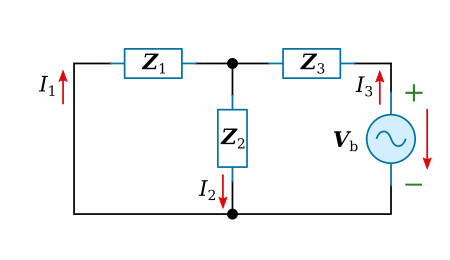Home > Textbooks > Basic Electronics > AC Network Analysis > Superposition Theorem >
AC Network Analysis
Superposition Theorem
The superposition theorem for AC circuits is:
The current in any part of a network containing two or more sources
can be calculated by analyzing the network one source at a time. The current
due to each source is calculated for each branch of the network. The net
current in each branch of the network is then the phasor sum of the
respective branch currents due to each source.
The next example demonstrates application of the superposition theorem to AC circuits.
Example 1:
Solve the circuit of figure below with the superposition theorem.


Solution:
1. The impedance network with Vb deleted, as shown in the figure below, can be solved for the branch currents due to Va only.


2. The impedance network with Va short-circuited, as shown in the figure below, can be solved for the branch currents due to Vb only.


3. The net branch currents are the phasor sums of the branch currents due to Va and Vb.







